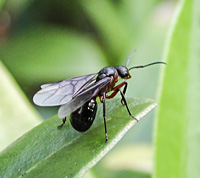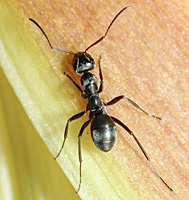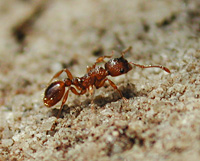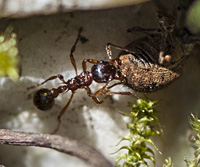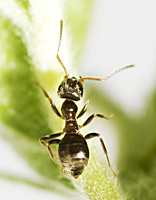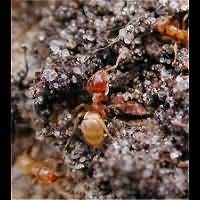[All pictures of garden wildlife on this page are thumbnails. Click on any thumbnail for a large format to be displayed.]
As we associate ants with the tiny nuisances that with many thousands crawl all over our gardens (and sometimes even inside our houses as well), it is probably surprising to realise that ants actually belong to the group of flying insects. Several times a year though the ants actually do fly. The individuals that take off are males and young queens. After copulation which takes place high up in the air the males die and the queens get off to find a place to start a new colony. The ants you normally see, the busy-bodies hurrying from who-knows-where to who-wants-to-know-where are workers. These never get wings. All ants are 'social' insects which live in huge colonies. Their nests are usually hidden underground, but some ants built their constructions above the ground which sometimes reach impressive dimensions.
Red Wood Ant (Formica rufa)
The Red Wood Ant is very uncommon in gardens. It is the one building high 'ants hills' in European woods. More...
The Red Wood Ant is very uncommon in gardens. It is the one building high 'ants hills' in European woods. More...
Common Black Ant (Formica fusca)
The Common Black Ant is one of the biggest ants species in Western Europe. More...
The Common Black Ant is one of the biggest ants species in Western Europe. More...
Common Red Ant or European Fire Ant (Myrmica rubra)
Both Myrmica rubra and Myrmica ruginodis are commonly referred to as (Common) Red Ants. M. rubra is the only one that has been introduced to Northern America. There it is called the European Fire Ant. More...
Both Myrmica rubra and Myrmica ruginodis are commonly referred to as (Common) Red Ants. M. rubra is the only one that has been introduced to Northern America. There it is called the European Fire Ant. More...
Common Red Ant (Myrmica ruginodis)
This Red Ant species has long thorns on the back of the thorax. It has not reached Northern America (yet). More...
This Red Ant species has long thorns on the back of the thorax. It has not reached Northern America (yet). More...
Black Garden Ant (Lasius niger)
The Black Garden Ant is probably the best known ant species. More...
The Black Garden Ant is probably the best known ant species. More...
Yellow Meadow Ant (Lasius flavus)
The Yellow Meadow Ant often makes little ants hills in lawns and meadows. More...
The Yellow Meadow Ant often makes little ants hills in lawns and meadows. More...

© Copyright 1998-2024 gardensafari.net (Hania Berdys)

 English / engels
English / engels  Dutch / nederlands
Dutch / nederlands